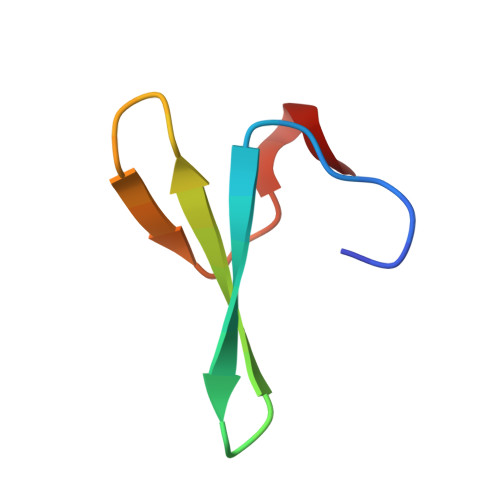Preventing fibril formation of a protein by selective mutation.
Maisuradze, G.G., Medina, J., Kachlishvili, K., Krupa, P., Mozolewska, M.A., Martin-Malpartida, P., Maisuradze, L., Macias, M.J., Scheraga, H.A.(2015) Proc Natl Acad Sci U S A 112: 13549-13554
- PubMed: 26483482
- DOI: https://doi.org/10.1073/pnas.1518298112
- Primary Citation of Related Structures:
2N4R, 2N4S, 2N4T, 2N4U, 2N4V, 2N4W - PubMed Abstract:
The origins of formation of an intermediate state involved in amyloid formation and ways to prevent it are illustrated with the example of the Formin binding protein 28 (FBP28) WW domain, which folds with biphasic kinetics. Molecular dynamics of protein folding trajectories are used to examine local and global motions and the time dependence of formation of contacts between C(α)s and C(β)s of selected pairs of residues. Focus is placed on the WT FBP28 WW domain and its six mutants (L26D, L26E, L26W, E27Y, T29D, and T29Y), which have structures that are determined by high-resolution NMR spectroscopy. The origins of formation of an intermediate state are elucidated, viz. as formation of hairpin 1 by a hydrophobic collapse mechanism causing significant delay of formation of both hairpins, especially hairpin 2, which facilitates the emergence of an intermediate state. It seems that three-state folding is a major folding scenario for all six mutants and WT. Additionally, two-state and downhill folding scenarios were identified in ∼ 15% of the folding trajectories for L26D and L26W, in which both hairpins are formed by the Matheson-Scheraga mechanism much faster than in three-state folding. These results indicate that formation of hairpins connecting two antiparallel β-strands determines overall folding. The correlations between the local and global motions identified for all folding trajectories lead to the identification of the residues making the main contributions in the formation of the intermediate state. The presented findings may provide an understanding of protein folding intermediates in general and lead to a procedure for their prevention.
Organizational Affiliation:
Baker Laboratory of Chemistry and Chemical Biology, Cornell University, Ithaca, NY 14853-1301; gm56@cornell.edu maria.macias@irbbarcelona.org has5@cornell.edu.














